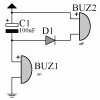iflymyhelishigh
New Member
Well, I am an electronics noob, so I am studying up on the 555. I am still very vague on it, and am trying to learn. Bad.
With that circuit, would it be possible to change out the capacitor to a larger uF to have a longer beep time?
I see these circuits in things like my simple timer, but I can't replicate it or trace it. haha
With that circuit, would it be possible to change out the capacitor to a larger uF to have a longer beep time?
I see these circuits in things like my simple timer, but I can't replicate it or trace it. haha


